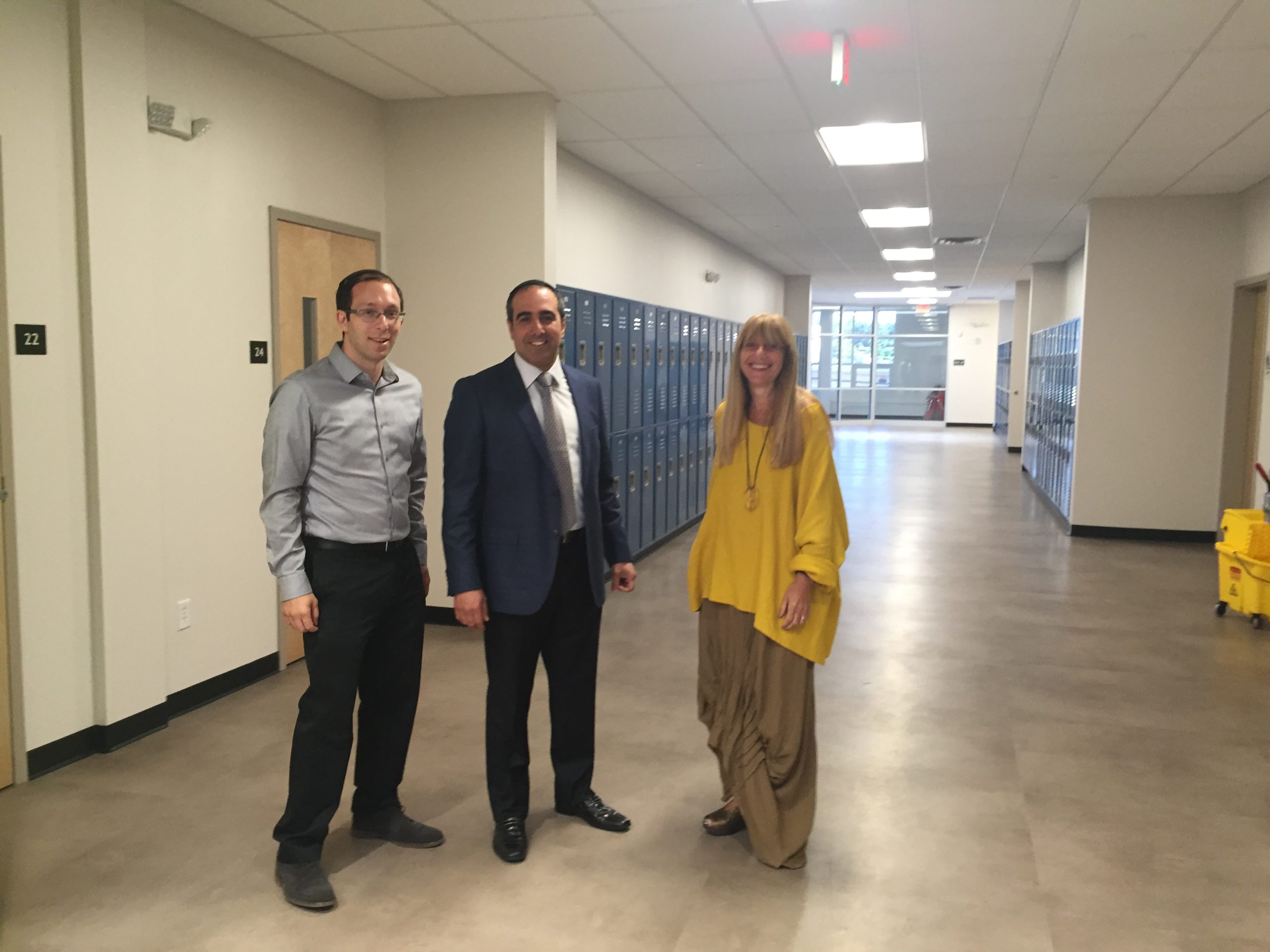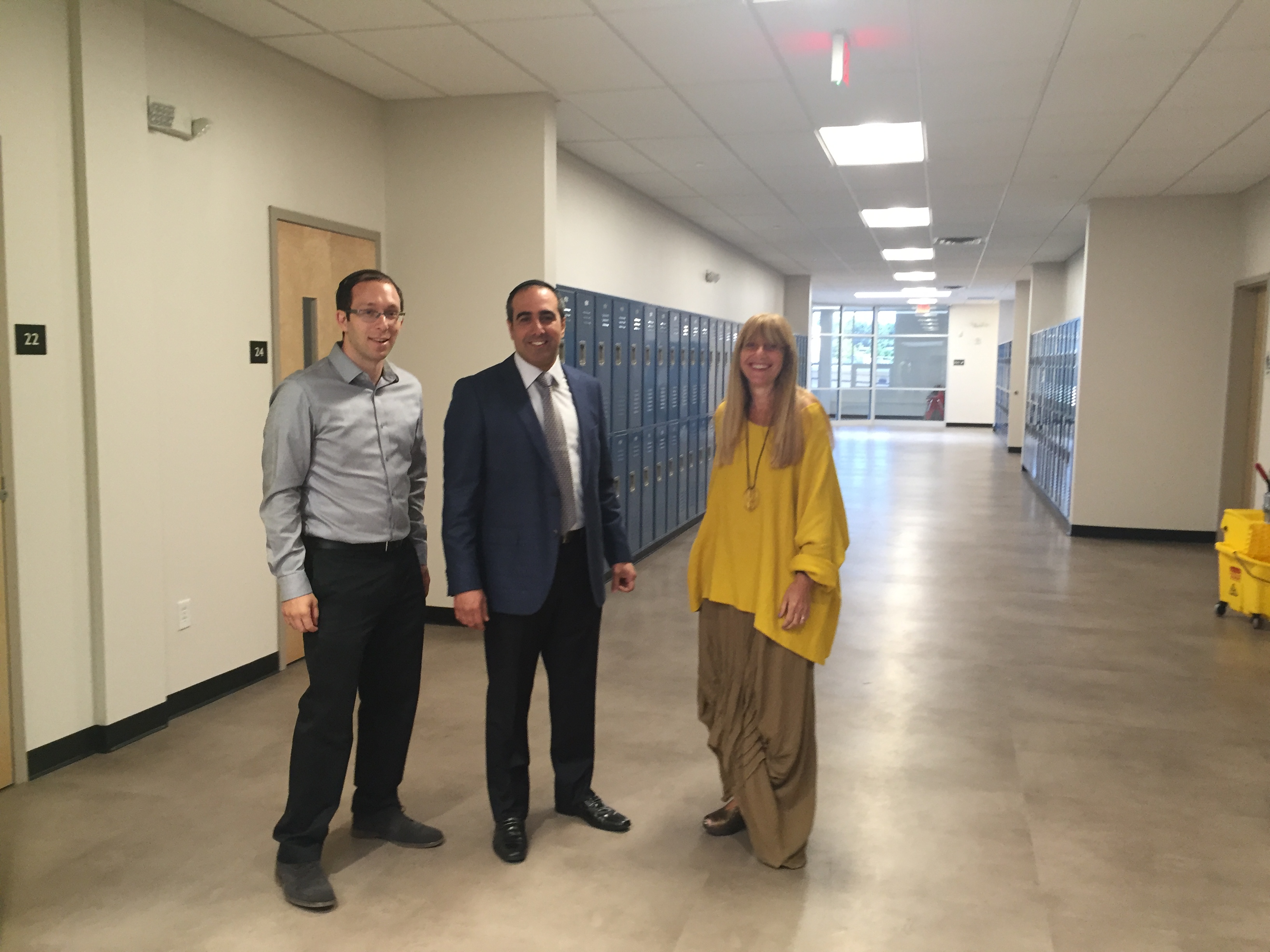Teaneck—An airy, multi-level and multi-wing yeshiva day school, with high ceilings, skylights, trendy, loft-style exposed ductwork and lime green accent walls is what greets visitors as they enter the new, beautifully designed 65,000-square-foot Yeshivat He’Atid building on 1500 Queen Anne Road.
The building, which is situated next door to Torah Academy of Bergen County near State Street, was purchased in November of 2014 and was completed at a breakneck pace, ensuring that the school’s 300 pre-k through fifth-grade students could begin the 2016-2017 academic year in their classrooms. The school’s 234 students the previous year were extremely cramped and had significantly outgrown their quarters on South Washington Avenue in Bergenfield. “We were like a six-person family living in a studio apartment,” joked Dr. Tani Foger, Yeshivat He’Atid’s principal. Also operating comfortably in the new building is a new outpost of Fair Lawn’s Kol Chaverim daycare, which hosts 60 young students, age 3 and under.
Yeshivat He’Atid, which opened in 2012 with 116 students, was launched by a group of Bergen County parents who sought to create an Orthodox yeshiva that would alleviate what is, for many, a crushing financial burden. It is now one of three schools in the country that pilots a blended-learning approach created by The Affordable Jewish Education Project (AJE), an organization created in 2011 by a group of private donors. AJE originated the “2 Sigma” education model, which subscribes to the notion that students working with differentiated, one-on-one-style learning tend to perform two standard deviations (2 sigma) higher than students learning traditionally. AJE also contributed funding toward the new building. An optional capital campaign geared toward the school’s parent and grandparent body helped the school with the purchase as well.
Along with Westchester Torah Academy (WTA), He’Atid shares the mission to provide high-quality, differentiated education to every student while actively striving to make day school affordable for working parents. Hebrew Academy of Long Beach, or HALB, is the third school that is using AJE’s education model in K through fourth grade in general studies; its existing model is also still present as well for the remainder of the school through 12th grade.
Rabbi Tomer Ronen joined He’Atid in July as its head of school, replacing Rabbi Netanel Gralla. He is also concurrently the head of AJE’s Schools Startup Network. Ronen previously was the beloved head of school at Ben Porat Yosef in Paramus. He shared that there are many advantages to being part of a day school system that includes multiple schools, and noted that collaboration on professional development, curriculum and even housekeeping items like purchasing with other schools inside a network makes a lot of sense.
“Education is always moving, changing,” the rabbi said. “This is healthy. But the onus should not always be on one individual school. If we can expand the number of participants in a professional development day with the same dollars, we save. We are running so many schools doing more or less the same thing; every school in this area, six schools, are working on their own curriculum, investing so many man hours on the same thing. You can share that if you have the right people, in all the schools.”
The flagship rotational model that is practiced in every He’Atid classroom is based on both teacher- and computer-guided activities broken into 15- to 20-minute increments. A classroom is split, generally, into three parts, with one third of the class working with the lead teacher, the second third working with the assistant teacher, and the remainder working on a computer assessment or lesson, which often resembles an educational game. The room buzzes with quiet activities, and at the conclusion of each quarter hour, each group gets up and travels to its next rotation in the same classroom. Peppered within the rotations are stories read aloud or short class meetings combined with snacks or mealtimes, recess on a playground outside, or sports in an inside gym. All classrooms have approximately 25 students.
While there are many online instructional programs for secular topics, there is only one for Hebrew, and it, like He’Atid, is in its development phases. The school is piloting a program with the longtime Hebrew instructional publisher TaL AM for online Hebrew learning, which offers computer programs through third grade. However, Rabbi Ronen dispelled the notion that He’Atid student education rests entirely on computer work, noting that because no program exists yet, there is no online component for Hebrew in fourth and fifth grade. “The concept is not just the computer,” but without that third rotation as a computer-aided activity “the teacher needs to be creative about managing the others students,” he said. Often, children work on independent projects during a rotation without a teacher or computer.
“And the children are used to it,” he added. “We are working with them, all the time, to train the children on the model. We work to use effectively the time that we have during the day.”
Dr. Foger shared that He’Atid’s shared curriculum and teaching design is based on three pillars: In addition to affordable Jewish education, small-group instruction in a rotational model, there is also complete Hebrew immersion.
“I’m particularly excited about our new kindergarten Hebrew initiative where our 5-year-old students are immersed in a total Hebrew-speaking environment for half of their school day. Teaching the He’Atid way means constantly challenging the status quo to provide the best 21st-century Jewish education, including second language acquisition, based on the most current research and literature,” she said.
Rabbi Ronen added that another major goal this year is to develop the curriculum and planning for the middle school, as He’Atid’s fifth graders will be middle schoolers next fall, before we know it. “On the task who we put to work on that are not just people from He’Atid, but WTA, even though they are only up to fourth grade. Working together on this makes sense for everyone,” he said. Rabbi Ronen added that the current budgetary priorities do not make it possible for the schools to support single-gender classes, though the school is a religious Orthodox yeshiva and works to maintain a high-level, Orthodox hashkafa. To that end, both Rabbi Ronen and Rav Yair Daar, the school’s assistant principal and mashgiach ruchani, both teach parshat hashavua and spend time with students on classroom activities each week.
All children have different learning schedules and learn differently, and the He’Atid model uses computer assessments that teachers can access at the end of each day to find out how each child is doing, and address each child’s strengths and weaknesses. Children with learning delays, children who are ahead of the curve and children with processing differences can and do coexist together comfortably in the same He’Atid classroom.
“With the right information, it [differentiated learning] can be done, with the teacher, in the class,” said Rabbi Avrumi Sacks, who, as chief academic officer at AJE, manages its education model. “It’s a more efficient way of doing it, and you’re creating fewer gaps, fewer people in the mix. But there will be a small percentage of kids for whom we still need to deliver services.”
Rabbi Ronen added that He’Atid students receive district services such as speech therapy or reading assistance just like at any other schools, and the school has almost finished building a sensory gym and a quiet recess area. With so much going on, is the buzz of a rotating classroom a good place for a child with sensory differences? “That kind of child is actually very comfortable in the He’Atid rotational model. In fact, the quiet rotational model is actually perfect for them, as every 15 to 20 minutes they are being moved and stimulated by another component in the classroom,” said Rabbi Ronen.
But the biggest news about He’Atid this fall may in fact not be at all about its new building and beautiful classrooms. Rather, it is that as the school closed its financial books last year, it broke even. “He’Atid’s cost per student sank to just $9,270 in the 2015-16 school year, below its tuition price of $9,350 per student for the first time since its 2012 founding. With 234 students and a tuition level 40 percent lower than local alternatives, He’Atid parents saved $10,500 per family, or $6,600 per student, for a total of over $1.5 million in 2015-16,” the school reported in a release. The school does raise a minimal amount for scholarships through an annual fun run, and offers them through a scholarship committee just like any other school, but there are vastly fewer “scholarship parents” at the school as most are paying what scholarship parents pay at other schools. “Most families can afford to pay the tuition, or very close to it,” said Rabbi Ronen.
“The assumption was, and to some extent still is, that you can either have an affordable school, or a good school,” said Jeff Kiderman, executive director of AJE. “This school, our flagship, is proving that it’s possible to have both.”
“The model actually worked. We broke even last year. This shows you can have an excellent school, and affordable,” said Rabbi Ronen.
“Schools are not always in a position to question or disrupt their own model, but there are other schools that are looking at He’Atid and saying, ‘now I will be able to justify transitioning to that approach,’” added Kiderman.
“It’s truly incredible to watch our dream become a reality,” said Abby Flamholz, president of He’Atid. “Our students are growing tremendously each and every year through our cutting-edge educational program, and their parents are saving millions of dollars in the process.”
Student scores appear to back up the school’s assessments as well. “He’Atid’s K-4 students demonstrated outstanding academic performance and growth on the Measures of Academic Progress (MAP) test. In 2015-16, He’Atid’s K‐4 students made more progress in math than 96 percent of U.S. students, and more progress in reading than 89 percent of U.S. students. In math, four out of five grades scored in the 96th percentile or above, and all five grades scored in the 91st percentile or above in reading. Although only 50 percent of students typically achieve above-average fall-to-spring growth nationally, almost 70 percent of students at He’Atid did just that,” the school reported.
“It’s inspiring to remember that Yeshivat He’Atid was once just an idea being explored by a few passionate parents in Bergen County,” said Kiderman.“He’Atid’s continuing success is a testament to both the hard work of its founders and the critical importance of the mission of delivering high-quality, affordable Jewish day school education.”
At $9,540 per student for the 2016-17 school year, He’Atid parents continue to pay 40 percent less than the price of local Modern Orthodox alternatives. “When we first opened Yeshivat He’Atid there were many who said that our mission was impossible,” said Gershon Distenfeld, chairman of the board. “We can now say confidently that high-quality Jewish day school education at an affordable price isn’t only possible—it’s already here.”
By Elizabeth Kratz













